Nokia Asha 201 Review
Nokia Asha 201
Is the Nokia Asha 201 a budget BlackBerry or a Qwerty keyboard failure?
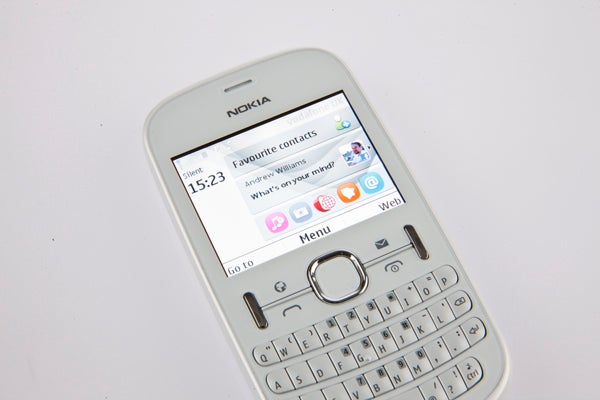
Verdict
Pros
- Decent keyboard layout
- Good chat functionality
Cons
- Slow connectivity
- Laggy apps
- Keyboard not crisp enough
Key Specifications
- Review Price: £54.99
- 2.4in 240 x 320 pixel screen
- Nokia S40 OS
- Physical keyboard
- 2-megapixel camera
- GPRS mobile internet
Now that virtually every phone can do the things once the preserve of the smartphone upper class – social networking, email, web browsing and so on – you might think that there’s not a great deal of difference between something like the HTC ChaCha and the cheaper Asha 201. They both have keyboards and a social networking slant.
The reality of using the Asha is quite different, though. With slow connectivity and poor app support, mobile phone fiends are better off spending a little more money. If saving cash is a priority, the Asha 201 isn’t out of contention yet. It costs less than the BlackBerrys it tries to emulate, while offering some of the typing bonuses associated with Qwerty phones.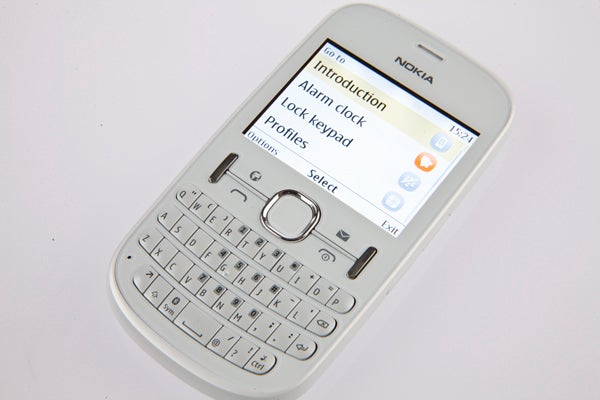
Closer to home, the Nokia Asha 201 is a little like the Nokia C3, one of our favourite phones of 2010. However, build quality has taken a hit to get down to a rock-botton price.
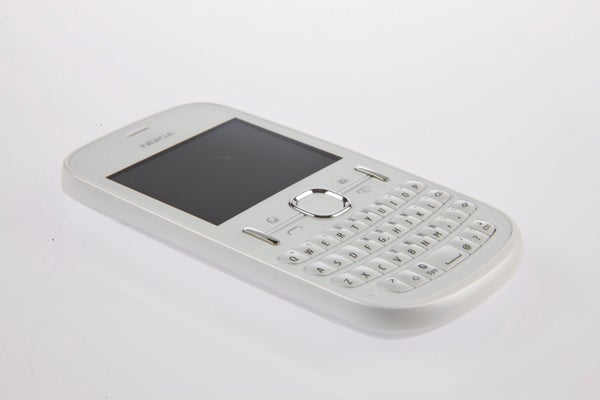
It is 100 per cent plastic, lacking the metal and glass that have come to define what an expensive phone should feel like. At 14mm thick, the Asha 201 isn’t super-slim either, but Nokia has aimed for a cute, rather than razor-sharp, look for this phone.
While it’s prettier than something like the Alcatel OT-799, there are a handful of tacky sprinkles atop its friendly look. The silvery soft keys and expanse of empty frontage ensure it doesn’t feel as carefully-designed as it could have been, a reminder that this is an “affordable” phone. The white version uses matt shades for its front and sides, adding a peppering of metallic sparkle to its glossy battery cover backplate.
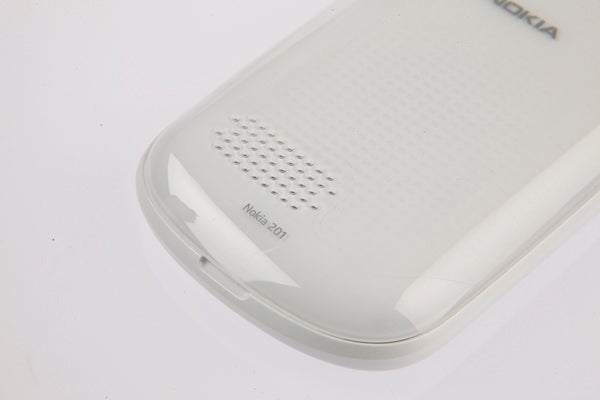
A work of art it is not, but – as ever with Nokia’s budget models – it feels as though it can withstand some punishment. The plastic used is thick and strong, and isn’t as prone to shattering on impact as the glass fronts of more expensive phones like the iPhone 4S.
Its sides are fairly bare. On the right edge is an unusually – and unnecessarily – large plastic flap hiding the microSD card slot, and up top are the microUSB slot, 3.5mm headphone jack and little Nokia charge socket. MicroUSB charging sockets have become the standard for almost all phones we review these days, but Nokia’s budget models still insist on using a proprietary type. The Asha 201’s battery refused to charge over microUSB, which may become an irritation if you already use a handful of microUSB-equipped devices.
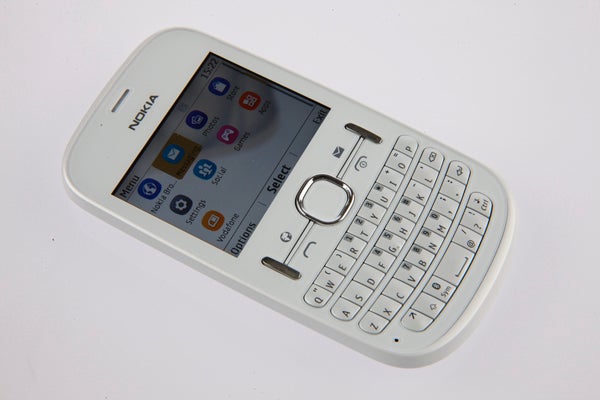
The most conspicuous hardware omissions are the volume rocker and a camera shutter button. These functions are catered-for using other keys, which isn’t optimal if, for example, you want to change the volume of a music track while the phone’s in your pocket.
The star of the Asha 201’s hardware, though, is its keyboard. It’s arranged in four discrete rows and keys are contoured to make touch typing easy once you’re used to its dinky size. Its design is well thought-out, making typing quicker and easier than either with an old clicky numerical keypad or a small touchscreen. However, the action of the keys could be crisper. With an indistinct feel, it doesn’t get close to matching the best of BlackBerry.
At present, the Asha 201 is available in black, white and pink in the UK. Nokia also makes green orange, blue and turquoise versions – but there’s no word on these coming to the UK at present.
The Nokia Asha 201 uses the proprietary S40 interface. This is a non-smartphone operating system, although Nokia has done its best to make it seem as smart as possible.
Its home screen features three slots you can fill with a variety of widgets including app shortcuts, social network update bars, your favourite contacts or email. There are 10 in total, making it restrictive compared with the free widget system of Android, but it does cover all the basics.

You have just the one home screen to play with, making it of limited use as the go-to spot for daily updates. The problem is that the small, low-res 2.4in 240 x 320 pixel screen can’t fit-in much information. To find the latest update using the home screen social networking bar, for example, requires four taps on the D-pad – hardly as convenient as a swipe or two upon a touchscreen.
The S40 operating system isn’t too hot at making text look both sharp and smooth. The low 166dpi pixel density is bad enough, but add Nokia’s workmanlike font selection and the Asha 201’s software never manages to look great. Clear? Yes. Classy? No. The screen also suffers from contrast shift, making the brightness fade when held in the wrong direction, and uneven backlighting.
Behind the home screen sits an icon-based apps menu where all the phone’s functions live. Other than phone calls and texting, the Asha 201 has dedicated apps for email, music, web browsing, and a hub for all your social network needs called Social.

The Social app ties-together support for Twitter, Facebook, Orkut and Flickr. Unlike some smartphone hubs, it doesn’t try to mash together tweets, Facebook updates and Flickr photos, but keeps them separate. However, each network’s interface is tweaked to better suit the content being spewed out.
Once again, the low screen resolution limits how much information can comfortably fit on-screen, but the bespoke interface makes reading tweets fairly easy. What really limits the Asha 201’s social networking is connectivity. The phone lacks both Wi-Fi and 3G, relying on the slower EDGE and GPRS connections. You’ll be left waiting for a handful of seconds as the latest Tweets and Facebook updates pop-up, and even longer if you want to take a look at a picture someone has posted. Video? Forget it – these 2G connections aren’t quick enough to make streaming enjoyable.
The connection speed issue also hampers casual web browsing. Like going back to the bad old days of dial-up internet, sites are very slow to load, especially those with plenty of images or other rich content.
The Asha 201’s inbuilt browser doesn’t support Adobe Flash either and relies on basic mobile sites rather than the full desktop versions. The keyboard makes typing web addresses in quick and easy, but without 3G or Wi-Fi, all of the phone’s connected features feel too sluggish to be much fun. When Android phones with 3G, Wi-Fi and the more intuitive navigation of a touchscreen are available for around the same price, the benefits of the preinstalled social hub start to disappear.
Sluggishness isn’t reserved for the Asha 201’s connectivity either. Apps are a little slow to load and run compared to those of a budget Android phone and the lack of any swish animated transitions in the S40 software makes the whole experience seem clunky and clumsy. Some considerate updates have been made to S40 over the years, but there’s no hiding that this is an outmoded piece of software.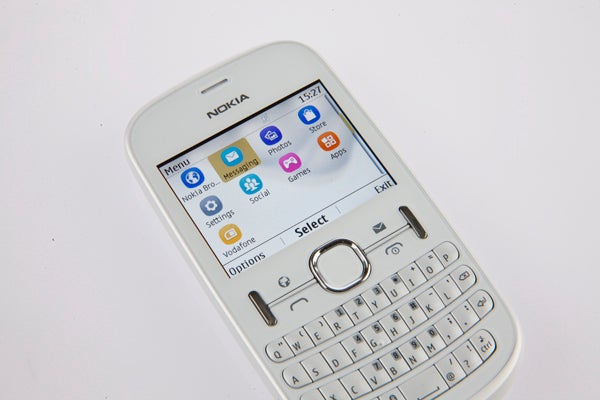
Within the S40 framework, the Asha 201 is much less useful for receiving “push” content like emails and online messages than a proper smartphone, too. You can tell the phone to check for new emails at regular intervals, but we found it was much slower to pick up on new alerts than a proper smartphone – even when set to search for new emails very regularly. If you want to see an email on your phone as you receive it, this isn’t the model to get.
Other apps that come preinstalled include a neat calendar app, which makes decent use of the widescreen aspect screen, a voice recorder and commuter favourite Solitaire. Access to the Nokia Store app store is hardwired into the Asha 201 as well.
The Nokia Store lets you download additional apps, both freebies and paid-for software, but most are of low quality. Games also tend to be a lot simpler, more like the 16-bit style games that were available on phone seven years ago than the snazzy titles Android and iPhone owners can enjoy today.
The Nokia Asha 201 may position itself as an all-round communication device, but the S40 OS and limited connectivity stop it from truly excelling outside of text messaging and basic online chat. As a replacement for the BBM service that low-cost RIM devices like the BlackBerry Curve 8520 have, the Asha 201 offers a comprehensive chat interface built-into the SMS text messagaing section of the phone. Although it would benefit from 3G or Wi-Fi, simple text uses so little data conversations aren’t slowed-down too much. 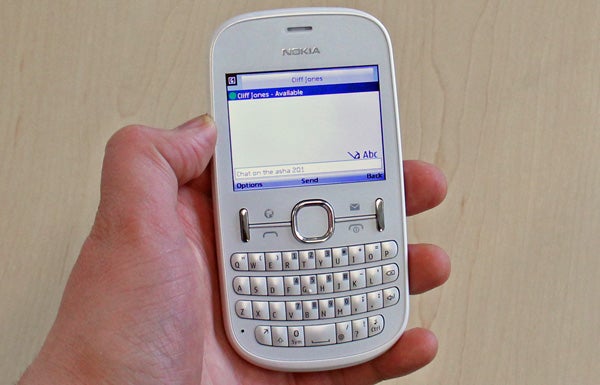
It can hook into your Facebook, Yahoo, Google Talk, MSN Messenger, MySpace and Ovi. Although the chat interface is bare-bones, offering such comprehensive functionality here is a big bonus. However, there will be costs involved if you’re on a pre-pay deal. BlackBerrys use their own low-cost data service for things such as chat, but with the Asha 201 you’ll be subject to the data charges of the network. It’s worth checking before chatting.
The Nokia Asha 201 proved a disappointment when asked with going online, but it fares a bit better as a music player. However, you will have to splash out on a microSD card as the 26MB of internal memory isn’t enough to house a single album.
Navigation of music is intuitive, letting you browser by Artist, Album and so on – as you would with an iPod. Like the rest of the interface, it’s not flashy but it is clear. The output from the 3.5mm headphone jack is also clean and offers decent volume output. There are no physical playback or volume buttons, though, requiring you to use the front d-pad to navigate between tracks.
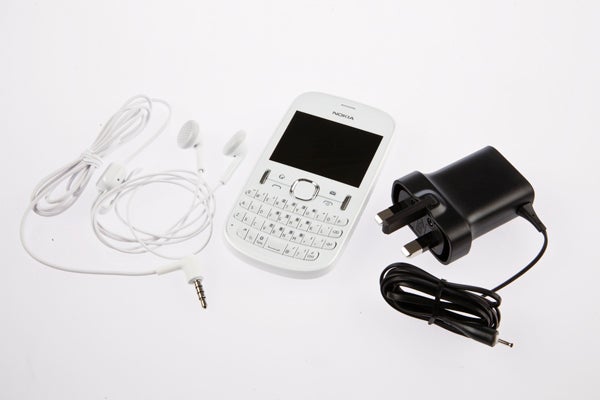
Nokia includes a headset with a single-button remote, but as the earbuds are non-removable and fairly poor, music fans will want to plug their own set in. A good FM radio is also built into the Asha 201. It uses the headphone cable as an antenna, reaps a good signal and will automatically scan for radio station upon first use. You cannot record the radio signal to phone’s memory, but this is an above-average mobile radio, where many mobiles’ offerings feel like a tacked-on afterthought.
The camera isn’t a similar success, though. Its chunky lens housing looks better than that of many a budget phone, but its specs are woeful. There’s no flash, resolution is a limited two megapixels and it has a fixed focus. This is an extremely basic camera only capable of papping throwaway shots.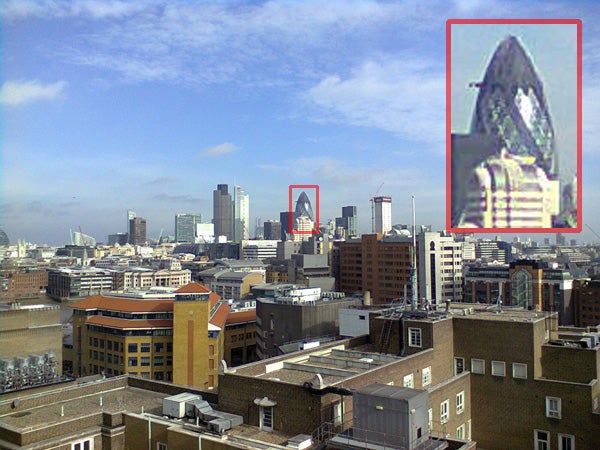
In good light the Asha 201 is can create photos worth posting on Facebook. However, its 2-megapixel sensor doesn’t offer a great deal of resolution and detail captured is limited. Photos are a great deal smaller than those of a 5MP or 8MP phone too – the Gherkin cut-out above had to be blown up beyond pixel level to be this large. Purple fringing is clearly evident, as is the overall lack of fidelity.
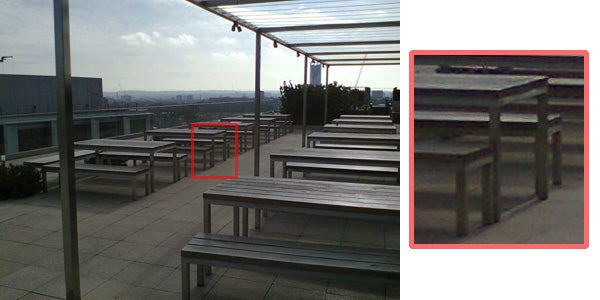
In more challenging light conditions, the Asha 201 really starts to struggle. Here, the scene appears desaturated. The blue sky has been all-but turned grey, and there’s a fuzziness to detail that you wouldn’t see from a higher-end camera.
The clearest annoyance in the use of a fixed focus – rather than autofocus – is that the camera cannot make close-up objects look sharp. Here, the leaves are affected. Any subject needs to be a metre or two away to appear in focus, severely limiting what you can snap – without resulting in a blurry mess.
Given this mediocre performance, it’s surprising that the camera app is one of the flashiest parts of the phone. Unlike the rest of the software, it’s packed with neat animated transitions and cute menus. The functionality it offers – a few colour effects, white balance settings and control over the quality of shots – is nothing special, mind. The Nokia Asha 201 lets you upload any images taken to your social networks, through the Social app, but as the connectivity types available are all quite slow, it’s best avoided. 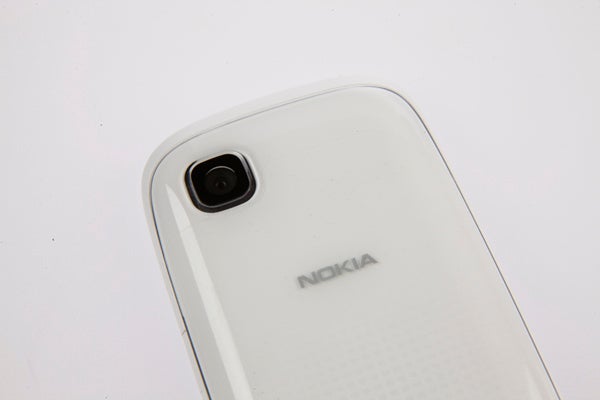
A 1430mAh battery powers the Asha 201. This is a decent size for a phone with a small screen and no 3G connectivity. In a smartphone, constantly plugging into the internet using 3G is what digs away so heinously at a battery’s stamina. Here, you’ll be able to enjoy at least 2 days’ use as long as you don’t make the phone search constantly for emails, or spend too long browsing the web. It’s rated for seven hours of call time, which betters many recent mid-range Nokias, including the X3-02 Touch and Type.
Call quality is decent but unremarkable. The earpiece is fairly loud, but the loudspeaker isn’t and there’s not noise cancellation – no surprise at the price, but it will making calls in noisy conditions frustrating.
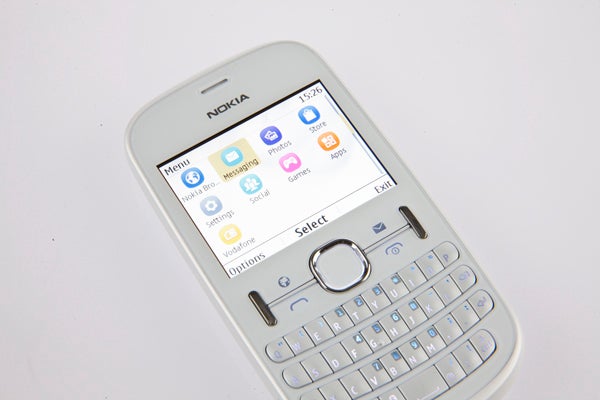
For around £50, the Nokia Asha 201 may sound like a good deal. It can access social networks, grab emails and browse the web, but without the software or connectivity to do the job properly, such abilities don’t add up to much. The Nokia C3 is now available at a similar price and, packing Wi-Fi, is an altogether much better-equipped phone.
Verdict
If you need a phone with a physical keyboard, the Nokia Asha 201 is one of the cheapest you can get. However, its outdated OS and slow mobile internet connections stop it being much use in its role as a social networking and email tool. Other phones around the same price offer both Wi-Fi and 3G, making this phone feel as though it’s stuck in the past.
How we test phones
We test every mobile phone we review thoroughly. We use industry standard tests to compare features properly and we use the phone as our main device over the review period. We’ll always tell you what we find and we never, ever, accept money to review a product.
Trusted Score
Score in detail
-
Design 6
-
Usability 6
-
Value 6
-
Features 5
General
| Available Colours | Black, White |
Display
| Screen Size (inches) (Inch) | 2.4in |
| Screen Resolution | 240 x 320 |
| Touchscreen | No |
Storage
| Camera (Megapixel) | 2 Megapixel |
| Front Facing Camera (Megapixel) | No Megapixel |
| Camera Flash | No |
Connectivity
| Bluetooth | Yes |
| WiFi | No |
| 3G/4G | No |
| 3.5mm Headphone Jack | Yes |
| Charging/Computer Connection | Yes |
Misc
| App Store | Yes |
| GPS | No |


